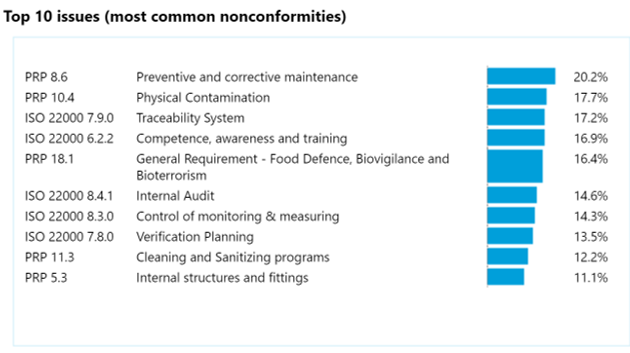If analyzing certification audit data, we see that many companies struggle with the same processes. This does not mean that their products are unsafe, but it provides insight into where to focus efforts. Where are the biggest risks? The data provided shows insight from 2019 for companies certified by DNV GL to the food safety standard FSSC 22000.
The analysis includes audit data of more than 1,800 certified companies and provides targeted insight into the aggregated performance of these companies’ management systems and what food production process areas or activities cause the most issues.
What are the top findings?
Identifying the main risk areas is done by analyzing all audit findings that have to be corrected in order to be compliant to the chosen standard, in this case FSSC 22000. This includes those categorized as critical non-conformity, major non-conformity (Cat1) and minor non-conformity (Cat2). The FSSC scheme is comprised of 3 elements: the ISO 22000 food safety standard, the ISO/TS 22002 pre-requisite programmes and FSSC’s additional requirements.
The reality revealed is that 86% of companies audited to FSSC 22000 experienced at least one finding in any category, i.e. a critical non-conformity, a major non-conformity (Cat1) or a minor non-conformity (Cat2). While it may seem like this should be cause for concern, it is in fact proof that having a structured, managed approach to food safety is necessary and works to address food safety issues that otherwise would maybe have gone undetected. Moreover, it is the foundation for a continual improvement process.
Chapter 7 of the standard, which includes requirements on planning and realization of safe products, is the area most at risk. More than 55% had findings can be found in this area, which is not surprising considering that this is the technical section of the standard.
There is a small jump to Chapter 8, where more than 35% of the companies had findings. This chapter is from the ISO 22000 standard and covers validation, verification and improvement of the Food Safety Management System.
For ISO/TS 22002, which specifies the requirements for establishing, implementing and maintaining prerequisite programmes (PRP) to assist in controlling food safety hazards, 29% of findings were found in PRP 10 (Measures to prevent cross contamination). When it comes to FSSC’s additional requirements, 27% of the companies had findings.

Sub-processes: Top 10 most frequent failures (non-conformities)
When digging a bit deeper into each sub-process of the standard, we see that non-conformities often occur within the pre-requisite programmes (PRP). These are often isolated incidents of a failure to meet the requirements of a specific clause.
When it comes to the ISO 22000 standard requirements, traceability is among the top 10 issues. This is often related to testing of the traceability system or missing records. Competence, awareness and training is also high on the list. The issues often relate to records of training or demonstration of competence criteria.
Insight into what already certified companies struggle with can help others prioritize improvement efforts and resources where it matters the most, whether just starting implementation of a food safety management system or seeking certification for the first time.
DNV GL’s 2019 ViewPoint survey Food safety: What’s next to assure its future? clearly indicated the value of certification in advancing food safety. The top benefit selected among the 1,600 companies responding was Compliance to laws and regulations (86,3%), confirming certification as an excellent tool to address main food safety risks. Other main certification benefits were product quality/safer food (79%) and better employee awareness and culture (78%). The latter suggests may support addressing food safety culture risks. Moreover, in the recent ViewPoint food and beverage consumer survey 69% indicated a willingness to pay more if the products or manufacturers are certified by a third party.
Want to know more? Have a look at our ViewPoint report ‘Food safety: What’s next to assure its future?’.